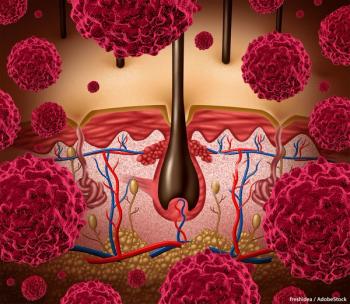
Oncology NEWS International
- Oncology NEWS International Vol 6 No 9
- Volume 6
- Issue 9
Lasting Melanoma Remissions With Biochemotherapy
SAN FRANCISCO-About 8,000 people will die of malignant melanoma in the United States this year, victims of a mortality rate approaching 100% in recurrent disease. Sewa S. Legha, MD, painted this grim picture at the Proleukin First International Congress, sponsored by Chiron. Traditional chemotherapy produces response rates up to 40%, but complete remissions are rare, even with the most aggressive combination therapies.
SAN FRANCISCOAbout 8,000 people will die of malignant melanoma in theUnited States this year, victims of a mortality rate approaching 100% inrecurrent disease. Sewa S. Legha, MD, painted this grim picture at theProleukin First International Congress, sponsored by Chiron. Traditionalchemotherapy produces response rates up to 40%, but complete remissionsare rare, even with the most aggressive combination therapies.
Biological agents produce a different profile. Response rates to interferon-alfa(IFN-alfa) and interleukin-2 (IL-2, Proleukin) are around 20%, with durationof response and median survival similar to, and in some studies higherthan, those of chemotherapy.
In the late 1980s at The University of Texas M.D. Anderson Cancer Center,where Dr. Legha is professor of medicine in the Department of Melanoma/SarcomaMedical Oncology, researchers began combining the two types of therapy.
Based on the lack of cross-resistance and complementary mechanisms,Dr. Legha and his colleagues have developed a combined biotherapy-chemotherapyprogram that is more effective than either regimen alone.
Overall Response Rates of 60%
Among metastatic melanoma patients, overall response rates to the currentregimen have hit 60%, an unheard-of level with more traditional approaches.Complete response rates are 20%, again far higher than those achieved withother treatments. The median duration of response is eight months, but60% of complete responders remain in remission more than five years aftertreatment.
“There is a very good chance that these remissions will be long-lasting,”Dr. Legha said. And unlike many biochemo-therapy combinations, The M.D.Anderson program can be used effectively by community oncologists withminimal inpatient support.
The program has moved through several iterations, beginning with a six-weekalternating schedule of biotherapy (IFN-alfa plus IL-2) and combinationchemotherapy consisting of cisplatin (Platinol), vinblastine, and dacarbazine(DTIC). The next step was sequential biochemotherapy, ie, chemotherapyimmediately followed by biotherapy.
Concurrent biochemotherapy (see Table), the simultaneous administration of both components, provides a responsesimilar to that of the sequential regimen, Dr. Legha said. The five-daytreatment courses can be repeated at three-week intervals as needed, hesaid, but clinicians can expect to see prompt results. Patients who donot show tumor regression during the first two treatment cycles are unlikelyto respond at all, he added.
Toxicities are relatively moderate. Patients spend the first six toseven days of each cycle in the hospital, but intensive care support israre. Most patients experience fever, nausea, vomiting, moderate hypotension,and mild hepatic and renal dysfunction. Physicians can expect to writeliberal orders for antipyretics, antiemetics, antidiarrheals, and controlledintravenous hydration.
French Studies
David Khayat, MD, head of the Department of Medical Oncology, Pitié-SalpêtrièreHospital, Paris, France, has taken a slightly different approach to thesame problem. “We have been taught that metastatic melanoma is an incurabledisease,” he said at the meeting. “That is no longer an absolute.”
Dr. Khayat conducted three phase II clinical studies comparing the efficacyand survival of several doses and schedules of IL-2, IFN-alfa, and cisplatin,plus the trio with and without tamoxifen (Nolvadex). The response rateswere similar in all the groups, producing an overall response rate of 49%,including 10% complete responses.
The biggest difference was in survival. Patients who did not respondto biochemotherapy survived 7 months versus 17 months for responders. Morethan three years after treatment, 7% of patients remain in complete remission. The next step, Dr. Khayat said, is to boost the rate of complete respondersand move the treatment into ambulatory care.
Decrescendo IL-2 Dosing
Alexander Eggermont, MD, PhD, head of the Section of Experimental SurgicalOncology, University Hospital Rotter-dam-Daniel den Hoed Cancer Center,offered final results from a phase III EORTC trial of biochemotherapy.Dr. Eggermont is chairman of the EORTC Melanoma Cooperative Group (EORTC-MCG)and secretary general of the EORTC.
Patients with stage IV metastatic melanoma were randomized to receiveIL-2 plus IFN-alfa or IL-2/IFN-alfa plus cisplatin. Both arms of the trialused a decrescendo, or decreasing dose, regimen for IL-2, which was developedby Dr. Ulrich Keilholz, of the University of Heidelberg, who is currentlychairman of the immunotherapy subgroup of the EORTC-MCG.
“You actually deliver a larger IL-2 dose with decrescendo dosing, comparedto steady-dose regimens, but there is much better tolerance,” Dr. Eggermontsaid. In standard regimens, he continued, patients typically receive 70%to 75% of the prescribed drug because of dose-limiting toxicities. Thedecrescendo regimen reduces the incidence and severity of side effectsto permit delivery of 95% of the prescribed dose.
In spite of a significant increase in response rates and time to progressionin the combination arm with cisplatin, median survival and overall survivalrates were identical in both arms of the study. (For a fuller report ofthe findings, see J Clin Oncol 15:2579-2588, 1997.)
Value of Cisplatin ‘Debatable’
Cisplatin seemed to add only a number of relatively unimportant partialremissions of short duration, he said. Thus, the value of the impact ofchemotherapy on top of the effect of IL-2/IFN-alfa is debatable. (Thispoint was also put forward by Dr. Steven Rosenberg of the National CancerInstitute.)
At present, the EORTC-MCG is assessing the impact of IL-2 on survivalin a trial comparing dacarbazine, cisplatin, and IFN-alfa with and withoutIL-2. “It is time to assess whether adding toxicity correlates with addingmeaningful time to the life of melanoma patients,” Dr. Eggermont said.
Articles in this issue
over 28 years ago
IL-2 Shows Promise in Treating Hematologic Cancersover 28 years ago
Studies Show Who Seeks Mammography and Whyover 28 years ago
New Policy Board Enters Tobacco Frayover 28 years ago
Index Quantifies Bone Disease in Prostate Cancerover 28 years ago
Wynder Urges Nutrition as an Adjunctive Cancer Therapyover 28 years ago
Treating Other STDs May Reduce HIV Levels in the Semenover 28 years ago
Bisphosphonates Improve QOL in Bone Lesion Patientsover 28 years ago
Children Run Greatest Cancer Risk from Nuclear Testsover 28 years ago
Trials of IV SNX-111 Paused, but Phase III Pain Trials Continueover 28 years ago
IL-2 Termed ‘Gold Standard’ in Renal Cell CarcinomaNewsletter
Stay up to date on recent advances in the multidisciplinary approach to cancer.





